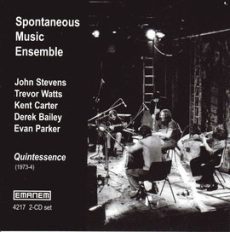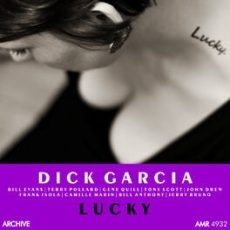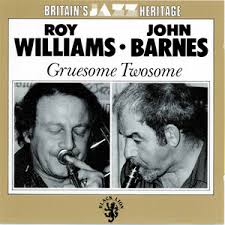
Daily Dose Of Jazz…
John William Stevens was born on June 10, 1940 in Brentford, Middlesex, England, the son of a tap dancer. He listened to jazz as a child but was more interested in drawing and painting, through which he expressed himself throughout his life. He studied at the Ealing Art College and then started work in a design studio, but left at 19 to join the Royal Air Force. It was here that he studied the drums at its School of Music in Uxbridge, England and where he met Trevor Watts and Paul Rutherford, two musicians who became close collaborators.
In the mid-1960s, Stevens began to play in London jazz groups with Tubby Hayes and Ronnie Scott, and in 1965 he led a quartet. He moved away from mainstream jazz when he heard free jazz from the U.S. by musicians like Ornette Coleman and Albert Ayler. By 1966, he formed the Spontaneous Music Ensemble (SME) with Watts and Rutherford. The band moved into the Little Theatre Club at Garrick Yard, St Martin’s Lane, London, England. In 1967, they released their debut album, Challenge, however, his interest turned to quiet music, non-Western music and improvisation.
Stevens would go on to play with free improvisors Derek Bailey, Peter Kowald, Julie Tippetts and Robert Calvert, until the mid-1970s when the SME settled down to regulars Stevens, Nigel Coombes on violin, and Roger Smith on guitar. During the same period he consistently played with guitarist and songwriter John Martyn as part of a trio that included bassist Danny Thompson, recording Martyn’s 1976 Live at Leeds.
The Eighties saw John becoming an educator involved with Community Music, an organisation through which he took his form of music making to youth clubs, mental health institutions, the Lewisham Academy of Music, and other unusual places. Notes taken during these sessions were later turned into a book for the Open University called Search and Reflect.
Drummer John Stevens died at the age of 54 from a heart attack on September 13, 1994.
More Posts: bandleader,drums,educator,history,instrumental,jazz,music

Daily Dose Of Jazz…
Alan Branscombe was born on June 4, 1936 in Wallasey, Cheshire, England into a family of musicians. His father and grandfather were professional musicians and began on alto sax at age six. As a child he played drums with Victor Feldman in a talent show as a child.
During his time in the Army he played with Jeff Clyne in 1954–56. He toured and recorded with Vic Ash in 1958, recorded with Tony Kinsey the following year, and toured Japan with Stanley Black at the turn of the new decade. Alan worked with John Dankworth as pianist and vibraphonist intermittently between 1960 and 1972, including in the 1963 film The Servant.
Joining Harry South’s band at Ronnie Scott’s club in the mid-1960s, Branscombe went on to play as a sideman with Tubby Hayes, Stan Tracey, and Paul Gonsalves through the decade. He played with Ben Webster in 1965 and again in 1970, and in the Seventies he was with Albert Nicholas, toured in Europe with Stan Getz, and played with the Lamb-Premru group around 1971.
As a leader Branscombe recorded with Tony Kinsey and Tony Coe as sidemen on the album The Day I Met the Blues in 1977. As a session musician, he played tenor saxophone on The Beatles song Got To Get You Into My Life.
Pianist, vibraphonist, and alto saxophonist Alan Branscombe died on October 27, 1986.
More Posts: bandleader,history,instrumental,jazz,music,piano,saxophone,vibraphone

Daily Dose Of Jazz…
Dick Garcia was born Richard Joseph Garcia on May 31, 1931 in New York City. He began to play the guitar aged nine.
In 1950, he was a member of Tony Scott’s quartet. From 1952, he worked with George Shearing, Charlie Parker, Joe Roland, Milt Buckner, Johnny Glasel, Lenny Hambro, Aaron Sachs, and Bobby Scott.
He recorded again with Shearing in the late 1950s and early 1960s, then with Kai Winding, Milt Buckner, Nat King Cole, Johnny Glasel, Lenny Hambro, Joe Roland, Bobby Scott, Tony Scott, and Nancy Wilson.
Guitarist Dick Garcia, who recorded as a leader and sideman, still plays occasionally at age 93.

Daily Dose Of Jazz…
Neil Richard Ardley was born in Wallington, Surrey, England on May 26, 1937. He attended Wallington County Grammar School and at the age of thirteen started learning the piano and later the saxophone. He studied chemistry at Bristol University, also playing both piano and saxophone in jazz groups, graduating in 1959 with a BSc.
Moving to London, England the next year he studied arranging and composing with Ray Premru and Bill Russo. He joined the John Williams Big Band as pianist, arranger and composer, and from 1964 to 1970 was the director of the New Jazz Orchestra. The band employed some of the best young musicians in London, including Ian Carr, Jon Hiseman, Barbara Thompson, Dave Gelly, Mike Gibbs, Don Rendell, and Trevor Tomkins.
The late 1960s saw Ardley begin composing, combining classical and jazz methods. The New Jazz Orchestra 1969 album Le Déjeuner sur l’Herbe is considered a classic of British jazz. It includes arrangements of Nardis by Miles Davis and Naima by John Coltrane, and compositions by young writers associated with the orchestra – including Ardley, Michael Garrick, Mike Gibbs, Howard Riley and Mike Taylor.
His rich orchestrations were augmented in the 1970s by the addition of synthesisers. He began work on an all-electronic album in 1980 which fell through when his recording contract was suddenly terminated, but continued to play and compose, especially with Zyklus, the electronic jazz group he formed with composer John L. Walters, Warren Greveson and Ian Carr.
Neil went on to sing in local choirs in the later 1990s led him to start composing choral music, and to gig and record again with a slimmed down Zyklus consisting of himself, Warren Greaveson, and Nick Robinson
Composer and pianist Neil Ardley, who was an author of popular books on music, died in Bakewell, Derbyshire, England on February 23, 2004.
More Posts: author,composer,history,instrumental,jazz,music,piano

Daily Dose Of Jazz…
John Barnes was born in Manchester, England on May 15, 1932. He started out his career as a flügelhorn player in the early 1950s, and adapted his playing skills to the clarinet, an instrument he favored. He played traditional jazz with Alan Elsdon, The Mike Daniels’ Delta Jazzmen and also The Zenith Six.
In May 1964, after a bad car crash Barnes was replaced by Al Gay, until his full rehabilitation as a member of Alex Welsh band. He continued and extended his career musically from 1967 with the Scottish dixieland jazz trumpet and cornet player Alex Welsh and his Jazz Band, which lasted ten years until 1977.
He began playing alto, baritone, soprano saxophone and the flute. During this period he rose to fame in the jazz arena appearing at the Newport Jazz Festival aged 37 in 1969. His skills on baritone saxophone earned him a huge jazz fan base, some suggesting he was the best they had seen in Europe. After leaving Welsh, Barnes worked as co-leader, with trombonist Roy Williams of the Midnite Follies Orchestra, which included many American jazz artists.
John worked with Janet Jackson, Leo Sayer, Humphrey Lyttelton, Gerry Mulligan, Spike Robinson, Bobby Wellins and Keith Nichols. He considered Coleman Hawkins and Johnny Hodges to be his two main saxophone influences throughout his career.
In 2011, while on holiday in Greece, Barnes suffered a stroke. As a result of his stroke, a benefit concert was held for him the following year at the 100 Club in Oxford Street, London.
Saxophonist, clarinetist and flutist John Barnes died on April 18, 2022 at the age of 89.
More Posts: bandleader,clarinet,flute,history,instrumental,jazz,music,saxophone



